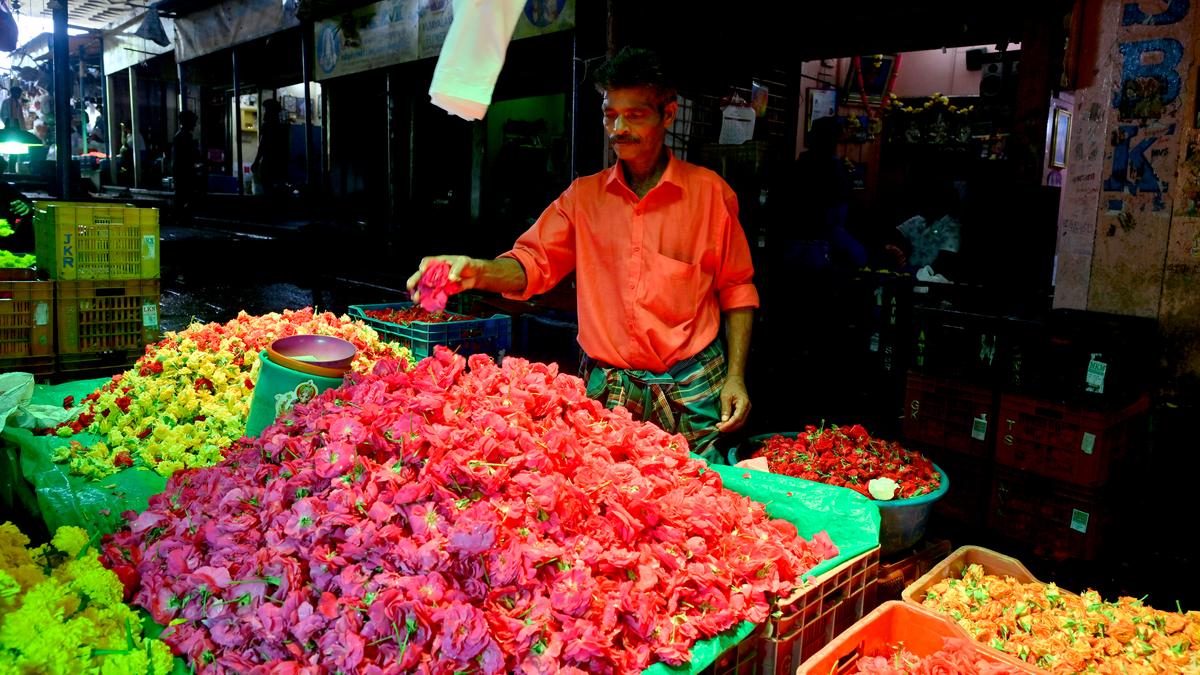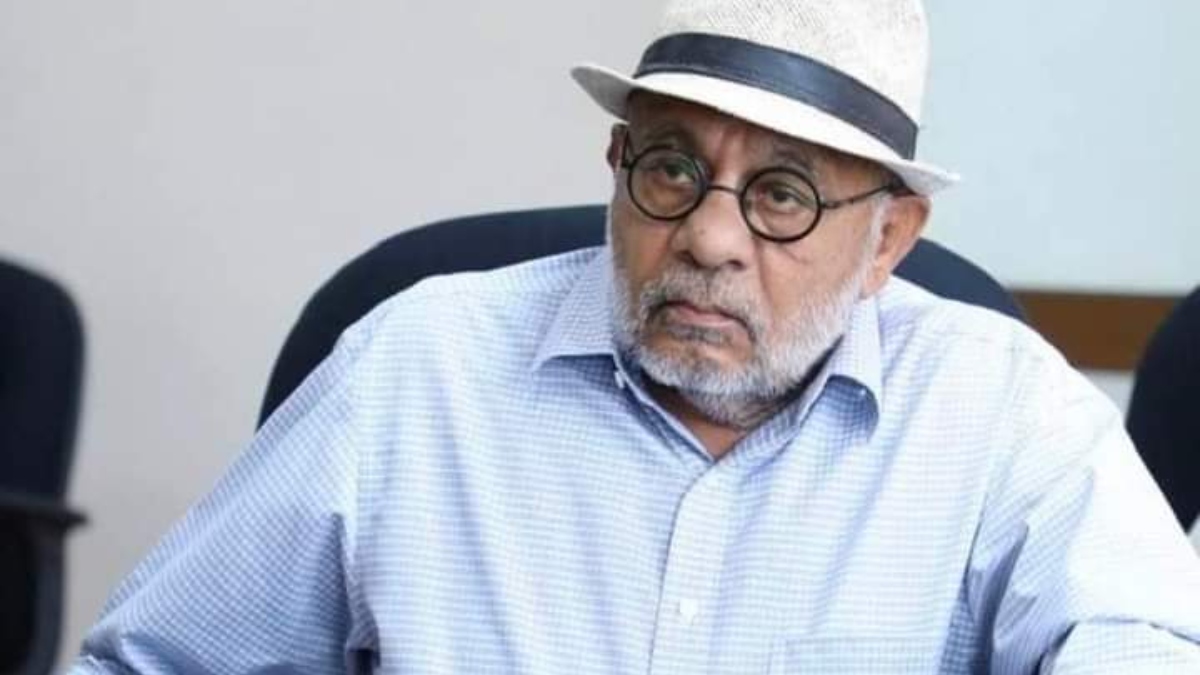Koyambedu flower market Comparing the setting before my eyes — a flower market, to a scene out of a neo-noir film might be odd, but that is exactly what strikes me when I make my way into the long row of shops selling loose flowers at the Koyambedu flower market. The place is bathed in an eerie green glow, white bulbs are hanging low right above crates and piles of flowers, and there is the deafening chatter of sellers calling out to customers. It is all about the florals here — you can choose from garlands, hair ornaments, long-stemmed blooms for bouquets, and large flower arrangements for events.
“Don’t stand in the way,” I am told by at least two women making their way through the throngs of people with heavy bags. Here is where several women like them come to buy flowers in bulk, for small flower shops that dot the city. There are baskets filled with jasmine flowers at S Kumaran’s store, but I take a step back once I hear the day’s price is at ₹1,300 a kilo.

“Earlier this week, it went up to ₹1,500!” he says. I settle for a kilo of orange marigolds, priced at ₹40 . Kumaran stuffs a cloth bag to bursting, a marked departure from how delivery apps usually sell a handful for over twice the amount I am paying here for a kilo.
Shops at the Koyambedu flower market| Photo Credit:AKHILA EASWARAN Amidst the piles of button roses, marigolds, jasmine, and yellow chrysanthemums, pops of purple catch my eye. Purple chrysanthemums, I am told, are all the rage now and I give in once again, for a kilo of ₹40. At the rows of shops selling garlands for every occasion, men deftly string up roses, lotuses, and jasmine, and are disappointed when I say I have no big event to shop for.
I am however promptly directed towards the quieter part of the market at the back, where rows of roses, gerberas, sunflowers are placed in buckets. I am tempted by the bright sunflowers and the lilies, but given the budget, pick a bunch of lovely, light pink long stemmed roses for ₹120. “We only have around 20% of our regular business at the moment.
This isn’t the season for weddings,” a florist there says. Now that the Aadi month has finally ended, I can only imagine the flower market must be twice as crowded. ₹200 seems too measly a budget, for all the colours and petals that seem to exist in this bubble.
Two and a half kilos of flowers does not seem enough. - S Poorvaja Pallavaram market Shoppers at Pallavaram Friday market A young Raghav M has bunked school and got his dream gift from his parents: a puppy with blue eyes for ₹2,000. I gaze at the enthusiastic puppy, finding a fresh home in Raghav’s comforting arms, only to be cut short by a person who has thrust a cat in my hands.
“Just ₹3,000 sir. It’s a cheap Persian cat,” he says. I don’t need a pet.
Nor do I have ₹3,000 to spend. Because, this challenge gives me just ₹200 and I’m set to get value for money. I am at Pallavaram Friday Market and this is exactly where you should be on Friday evenings if you are looking to buy anything.
Did I say anything ? Darn right yes, because at this iconic sandhai (shandy) that operates only on Fridays and boasts a 100-year-old history, you just can about get anything. I make my way past the animals sections and arrive at the main bazaar. There is a ₹15 shop; here, you can pick up a small tumbler or spoon.
Another place sells rare coins; you can get an old ₹1 coin for ₹10 here. And yet another shop sells shoes for ₹300. The largest crowd has assembled for an outlet that is selling branded chips and flavoured milk at almost half the price.
I am tempted to try it, but there is just no space to wriggle through. Tired from all the walking and a lack of decision-making skills, my gaze falls on a snack stall. There are cashew biscuits for ₹70 here.
I seal the deal, planning to bid my stay-off-sugar phase goodbye. A black dupatta for the better half at ₹50 and two pairs of socks for my little girl at ₹50 and I’m done. Wait, I still have money left, and someone is shouting: ‘soodana Madurai paruthi paal’.
I have a glass and buy a ‘magic balloon’ to keep my daughter entertained during the weekends. My ₹200 is well spent and I head back, promising to return to the sandhai soon with a shopping list. Fridays will never be the same again.
- Srinivasa Ramanujam Nochikuppam fish market With their fresh catch| Photo Credit:RAGU R The boat slides into the beach with a whoosh. Two fishermen in shorts hop off and drag it further into land. The net, rolled into a bundle in the middle of the boat, will soon be extracted to reveal the day’s catch.
Fisherman S Senthil hauls it to the Nochikuppam fish market. The 40-year-old has a quick bath nearby before settling under a shade near the Lighthouse on Loop Road in front of a plastic sheet that displays his catch. The Nochikuppam fish market is among the only places in Chennai where one can buy fish fresh off boats from the hands of the very men who caught them.
The market, that consists of a few dozen shanties by the strip of sand behind the Lighthouse, took shape in the 1980s, with the Nochikuppam Cooperative Society under the Fisheries Department, being formed as early as 1945. Named after the settlement of fisherfolk in the neighbourhood, the market is helmed mostly by women, who also cut and clean fish. With a budget of ₹200, I try hard to not be tempted by the seer and pomfret that cost ₹1,000 and ₹700 a kilogram.
I also steer clear of K Kalyani’s stall that boasts a hillock of prawns in three sizes, the biggest of them selling for ₹500 a kilo. The best kind of fish is that which is fresh off the net, and after a quick tour of the market, I head back to Senthil’s spread. He has smaller varieties such as sankara, sheela, nethili, kavala, and kanangeluthi all of which cost less than ₹200 for roughly a kilogram.
“For that amount, I also recommend the poruva,” he says. The small variety has lots of bones and can be quite tiresome to eat. “But it is the best,” he says.
“We make thick sunda kuzhambu with it that we pack to be had at sea.” Nochikuppam fish market| Photo Credit:RAGU R The men selling from nets do not weigh fish — if the catch is good, he will scoop a generous amount into your bag. If not, he will count every fish in front of him.
Luckily for me, Senthil also caught some crab that morning, and offers me six for ₹100. The stalls are set to relocate to an indoor market constructed by the Corporation nearby. “We don’t know when that will happen,” says K Bharathi, president of South Indian Fisherman Welfare Association.
Until then, we can continue experiencing the market in its original setting. Loop Road though is becoming more congested by the day, and it is impossible to cross it during peak hours. But these are just minor inconveniences to put up with to shop at a fish market that is open to the sky and the sea.
- Akila Kannadasan Moore Market Moore market on a sleepy afternoon| Photo Credit:Gowri S A quick stroll to the Moore Market Complex of today, past the ever-busy Chennai Central Suburban Terminal is all kinds of eventful. Flanked on either side of the road are push carts selling shiny (almost new) mobile phones. “We have iPhones too!” one of the vendors called out.
Further ahead, as one closes in on the remnants of one the oldest formal market of the city, it quickly changes character as stacks of books take over and the call becomes, “Books, ma’am? Medical, Engineering entrance coaching?” After the Indo-Saracenic building, a major Madras landmark, was destroyed in a fire in the 1980s, Moore market found a new home inside the Lily Pond Complex nearby. Armed with a ₹200 note, I walk into stalls bursting at the seams with books. But where once were stacked novels, now are stout educational books and the odd early edition Tinkle magazine.
I sift through multiple stalls to find a rare 1932 biography of Abraham Lincoln by Dale Carnegie, The Unknown Lincoln, for a grand total of ₹60. This sets me off on a wild book chase, which ends in a tattered 1966 edition of Edgar Wallace’s The Joker, which looks like it suffered a recent termite attack. Quoted at ₹85 first, upon bargain, the price is brought down to ₹60.
“If you are asking me for the cheapest book here, it’s the Tamil-English pocket dictionary for ₹10,” says Kaleem of Baskar Book House. I am down to the last ₹80. Do I have money for a cup of tea? Always.
Down to ₹70 now. Moore Market has a fiercely loyal customer base of antique collectors, young and old. A Visual Communication student from SRM, Kattankulathur is here on a weekday, busily digging into vinyls as the owner of Arun Collections’ (who wished not to be named) enlightens him of the greatness of Ilaiyaraaja.
A Magic of Boney M vinyl, wrapped in the cover of the 1977 Bollywood movie Taxie Taxie is a sure keepsake. After an endearing conversation centered around the life and times of a vinyl, I bargain. What is priced at ₹75 has been acquired for ₹50.
With ₹20 left, I walk in search of curios. But what stops me is indeed rare: A 1952 stamped postcard that records a response to an enquiry sent from Wildy & Sons to a person named JE Coleman Esq. in Burntwood Lane, London at Vickey Gallery Shop.
A quick Google search leads one to the Wildy & Sons website. With a 200-year legacy, they sell new, second-hand, antiquarian legal books and prints from Lincoln’s Inn, London. What one might never know is how this postcard, surprisingly in mint condition, made its way all the way to India, let alone this market.
While the bargain begins at ₹50, I fight tooth and nail to acquire it for ₹20. This has been a successful haul. Bits and bobs of Madras history within ₹200? Yes please.
- Gowri S Copy link Email Facebook Twitter Telegram LinkedIn WhatsApp Reddit The Hindu MetroPlus.



















